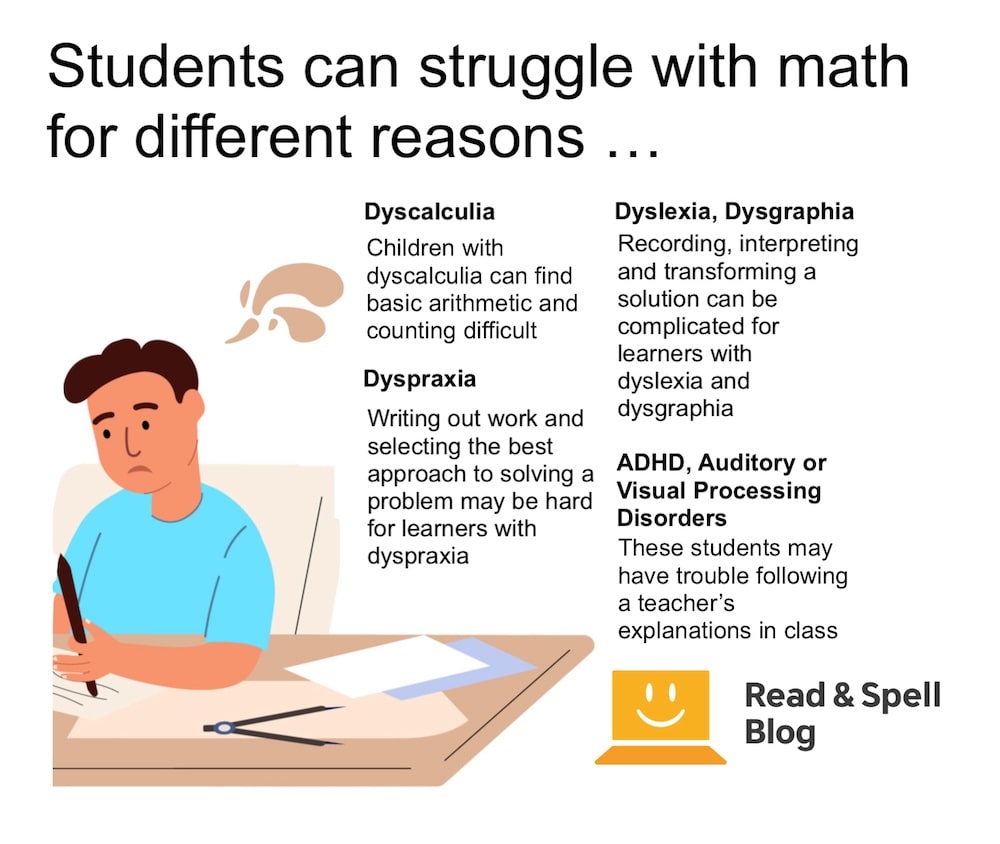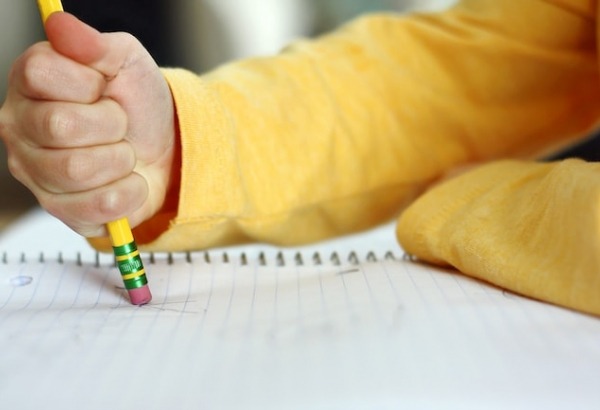Students struggling with math

Many kids have trouble with math, but some students find it more difficult than others. These may be otherwise bright children who have a keen sense of logic and reasoning but still perform poorly on homework, tests, and quizzes.
Over time, repeated underperformance in math can cause a student to become demotivated and believe he or she is “stupid” or not good at the subject.
Moreover, as math is cumulative, falling behind might mean a learner misses out on much of what is taught for the rest of the school term. Having basic math skills is important, regardless of the career an individual chooses to pursue.
That’s why it’s key to identify issues early on. Given the right combination of classroom accommodations and learning strategies, every student can achieve his or her full potential in math.
There are a number of reasons why a child may be having problems with math at school, from low motivation caused by math anxiety, to a poor understanding of how to apply and perform mathematical operations. But sometimes the root cause of under-performance is something different, like a learning difference or a motor skills disorder.
The most commonly associated condition is dyscalculia, in which individuals struggle with performing basic calculations and have trouble manipulating numbers in the same way as their peers.
However, students with dyslexia may also have a hard time with math at school due to difficulty reading numbers and following word problems. They might reorder digits when doing work out on paper, or solve problems correctly but record their answers in the wrong way.
Kids with ADD/ADHD can rush ahead and skip a step or struggle to focus and be unable to check their work once they’ve finished a problem.
Students with dysgraphia and dyspraxia, who have a hard time writing by hand, might become so distracted by number formation that they make careless errors or get the steps in an equation in the wrong order.
Lastly, children with visual processing disorders might lack the visual-spatial processing skills they need to align numbers, read graphs, and perform basic geometric operations.
How we think about math matters
Math is one of those subjects that is poorly understood by both children and adults. This is because whereas pre-school math is about practical problem solving, noticing patterns, recognizing shapes in your environment and learning to count, secondary and high school math instruction becomes more abstract. It often focuses on rote learning and solving equations in books – think arithmetic and times tables – which can turn students off and cause them to believe math skills aren’t relevant to their day to day life.
In fact, many students complain that math is boring. They may not see the point in learning algebra, geometry, or calculus at school. Or they may question why they need to be able to do basic arithmetic like addition, subtraction, multiplication and division by hand when answers can easily be found using a calculator or a computer.
The answer to this last point is three-fold. One, you may not always have a calculator available; two, even if you do, understanding how and why gives you a stronger basis for future learning, and three, doing arithmetic is a mental work-out that strengthens your working memory.
Numbers are all around us and being able to work with them quickly and efficiently is a great life skill to have. Note, being fast at arithmetic is also quite practical in many professions, from carpentry to retail, rocket science, and making the trains run on time!
However, math is about much more than arithmetic. A lot of what goes into solving multi-step word problems is identifying the problem, selecting an appropriate approach to solving it (there may be more than one), and following the right order of operations.
Getting the actual arithmetic right - the bit a calculator can do - is something that’s more straightforward. This is one reason why children are asked to show their work when doing homework or providing answers on a math test.
In some cases teachers may actually give out more credit for good work than the correct response. That’s because it is in the long-form, handwritten work that educators can see “math thinking” is taking place.
However, this approach may penalize the very bright child who leaps to the correct solution intuitively but doesn’t analyze how they got there, or the child for whom writing by hand is difficult. Recognizing individual students’ needs and strengths is at the core of excellence in teaching.

Who struggles with math?
- Learners with math anxiety
Research has shown that math is a subject in which success is highly affected by psychological factors, including anxiety. Anxiety is more than just a sense of worry – it’s a chemical reaction in the brain that can inhibit cognitive processing and cause physical symptoms, including fast breathing, heart palpitations and sweating.
Math anxiety may cause individuals who are otherwise strong students to freeze on a school quiz or exam.
They can have difficulty finding a way into a problem, misread questions, or complete far fewer problems than they are capable of. Many students with anxiety make careless mistakes because of the stress they are experiencing in the moment, and generally their timed test and quiz performance is of a poorer quality than classroom activities or assignments completed at home.
Math anxiety is not necessarily about being bad at math and it can affect learners across the spectrum of ability levels – even gifted children. Nonetheless it generally results in lower grades that undermine a learner’s confidence.
This mismatch between grades and knowledge/skills can be both discouraging and demotivating for students. In worst-case scenarios, a child may begin to show signs of math avoidance and display a negative attitude toward school and learning as a result of the anxiety.
It’s worth noting that some learners inherit math anxiety and/or avoidance from their parents. In Western societies it’s not uncommon to hear people express a dislike for math. In fact, it has become a culturally accepted way of discussing the subject in the US and UK. This can have an impact on learners who begin to devalue it as a subject or think it is acceptable to have lower expectations of themselves when it comes to doing math at school.
Also keep in mind that for some learners, math anxiety is the result of a history of poor performance due to an unaddressed learning or motor skills difficulty, or gaps in their learning history.
- Children with dyscalculia
Learners with dyscalculia have trouble doing basic arithmetic and may struggle to learn math facts. As under 5s they might have taken longer than their peers to master counting.
Dyscalculia can impact on estimation abilities and spatial reasoning too; these students might not be able to read time on clocks, make comparative judgements of size, or identify math symbols. It’s common for dyscalculia to co-present with other specific learning differences, like dyslexia, as well as attention difficulties.
TOP TIP: Calculators are a reasonable adjustment. Because students with dyscalculia may not be able to perform addition, subtraction, multiplication and division calculations reliably, they may need to use a calculator to solve complex math problems.
- Students with dyslexia
Dyslexia is a different way of processing in the brain which can make it more likely that students flip number and letter shapes, reverse numbers, or mix up their order. For example, copying a multi-digit number from one line to another can result in the student dropping a digit or adding one that wasn’t there.
There can also be problems that come from processing written language, as dyslexia affects a child’s ability to hear the sounds that make up words. This complicates reading and can impact on comprehension of word problems.
Students with dyslexia may need to reread a paragraph several times to understand it, they can easily lose their place when doing work out by hand, and may take much more time than their peers to get through the initial stages of understanding a prompt. This will consequently leave them less time to complete the actual math required to find the solution.
- Individuals with dyspraxia
Dyspraxia can affect the fine motor skills needed to hold a pen or pencil. Because most long form math is done by hand, dyspraxic students may struggle to show the steps they used to arrive at an answer.
The can easily become distracted or frustrated by the pain of handwriting and may be more likely to give up or abandon a question before solving it. Dyspraxia can also affect planning and organizational skills. As solving more complex problems involves a degree of planning as to how you will arrive at the answer, dyspraxic learners may find it difficult to get started.
They can also struggle with the sequence of steps and correct order of operations in math.
- Kids with ADD/ADHD
Attention difficulties can affect math skills in a number of ways. For one thing, they make it harder to pay attention in class. Working through a math problem requires you to track multiple steps; the answer to one line informs the next.
If a student drifts in and out of attention they might find it very challenging to follow a teacher’s demonstration and understand how a certain number has been derived. Maintaining focus is also a problem for doing work out by hand and checking work once a problem has been completed.
TOP TIP: Learners with attention difficulties may be more susceptible to anchoring effects. When you encounter a math problem you need to first focus on understanding what is being asked of you. Part of gathering the important bits is blocking out any anchoring effects from numbers that show up repeatedly and try to catch your attention. These numbers are normally there intentionally, to serve as distractors, but they can be problematic for certain learners. You may want to teach children to look out for these numbers so they can actively suppress their instinct to use them as an answer.
Children with ADHD with hyperactivity may be prone to rushing through math problems, and as a result can skip steps or make mistakes with arithmetic. They can put down answers impulsively or their handwritten work might be messy and hard to read.
Numbers that are difficult to decipher can confuse both the learner and the teacher – learn more about how handwriting difficulties affect students with ADD/ADHD.
- Learners with dysgraphia
One of the most important parts of doing a math problem is being able to put your thinking down on paper. This is so you can work in steps because holding multiple calculations in your head at one time puts a strain on cognitive resources and increases the chances of error.
However, for learners with dysgraphia, writing “math thinking” down can be a challenge. Dysgraphic students might struggle with forming numbers and symbols, organizing numbers spatially, and copying text from the board when taking notes.
They can have messy and disorganized written work that can be hard for them to read and cause them to get the wrong answer, even if the approach they took was correct. Learn more about dysgraphia.
- Individuals with visual processing disorders
Learners with visual processing disorders may have difficulty with math problems that involve spatial reasoning, including geometry, reading tables, reading maps and both discriminating and identifying different numbers. Learn more about visual processing disorders.

How teachers can make the math classroom more inclusive
Make math relevant.
Motivate learners by showing them real world situations that involve math use outside of school classrooms. Explain how math works, reassure learners that it’s not all about arithmetic, and get them excited about giving it a try and feeling comfortable trying out different approaches to problem solving, even if it means they don’t always get the right answer.
Teach in a multi-sensory way.
The teacher provides verbal explanations, shows work on the board, and if possible, uses tactile props that students can touch and move around. Multi-sensory input can aid learning by making it easier for students to engage with a lesson and can also reinforce material in memory. This is especially important for facilitating understanding in a subject that can be quite abstract.
Drill vocabulary in advance.
For some students, especially those who struggle with literacy, having the opportunity to practice reading, spelling, and typing math vocabulary and definitions can make it easier and faster to follow a lesson, read a textbook or understand what a problem is asking in homework or on quizzes.
TOP TIP: Have you ever considered how touch-typing can help learners with math?
Assign note-taking buddies.
Sometimes writing down information and processing it at the same time can be overwhelming for students. It might also be that copying from the board can cause numbers to be transposed or recorded in a way that the work no longer makes sense. It may help to allow a child to take notes using a computer, or to pair them up with a note-taking buddy.
Allow access to accommodations.
If a student has been diagnosed with a learning difficulty like dyscalculia, dyslexia or dysgraphia, you may consider allowing them to use a calculator to do basic arithmetic or a computer to type up and submit work. Touch-typing on a computer is often easier for children who struggle with the mechanics of writing by hand.
Give students more time.
The need for processing time in math can vary between students but children with learning difficulties often benefit from having more time to understand a concept and see how it works. It also helps to break work down into small steps and give each learner the time they need to process the line they are on before moving to the next one. Extending time limits can help with reducing math anxiety too.
A quick re-cap:
Students with dyscalculia, dyslexia, dyspraxia, attention disorders, dysgraphia, visual processing disorders and anxiety can struggle with math.
- Children with dyscalculia can find basic arithmetic and counting difficult
- Students with processing difficulties and ADD/ADHD may have trouble following a teacher’s explanations in class
- Selecting the best approach to solving a problem may be hard for learners with dyspraxia
- Recording, interpreting and transforming a solution can be complicated for learners with dyslexia and dysgraphia
- Students with math anxiety may have difficulty completing timed assessment measures or lack motivation because of low self-esteem or low-confidence
Touch-type Read and Spell
Touch-type Read and Spell is a multi-sensory typing program that teaches typing using a whole word and phonics-based approach. Students can take math typing modules created by teachers to match the curriculum at different grade levels. TTRS math modules teach basic definitions and help reinforce sight reading skills for key vocabulary. The approach works both for children and adults who struggle with math.
Use our Math Subjects to prepare for the year ahead, support classroom learning, or review previously learned material. Typing can give students with learning difficulties the confidence and skills they need to be successful!
For learners who struggle with dyslexia
TTRS is a program designed to get children and adults with dyslexia touch-typing, with additional support for reading and spelling.
Chris Freeman

close
Can an Orton-Gillingham approach to literacy help your child?
Take a short quiz to find out!
TTRS has a solution for you
An award-winning, multi-sensory course that teaches typing, reading and spelling

How does TTRS work?
Developed in line with language and education research
Teaches typing using a multi-sensory approach
The course is modular in design and easy to navigate
Includes school and personal interest subjects
Positive feedback and positive reinforcement
Reporting features help you monitor usage and progress














